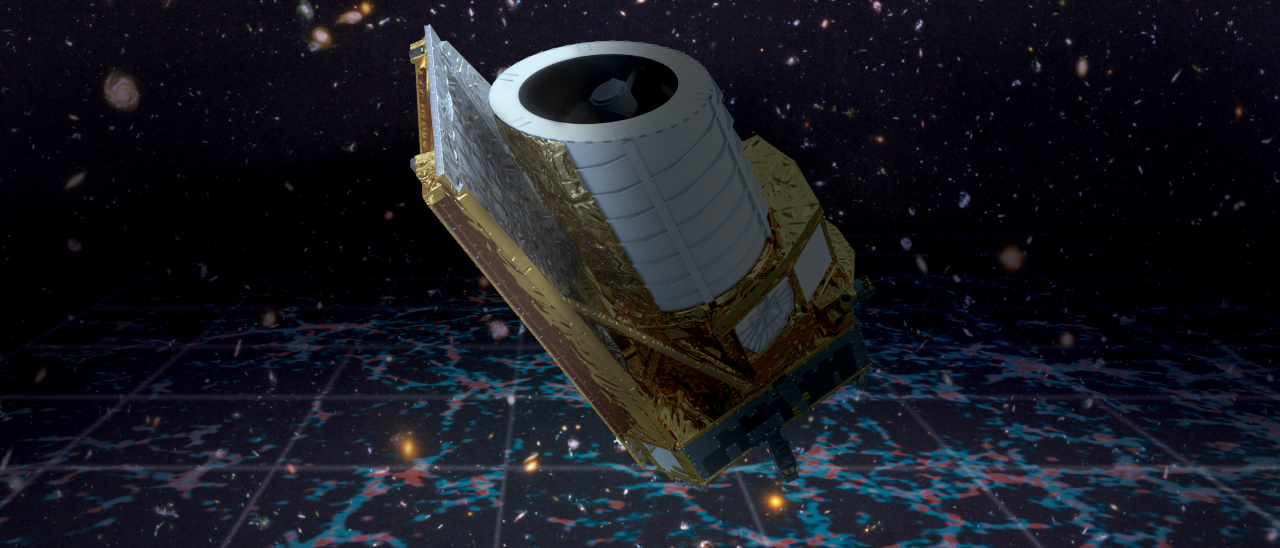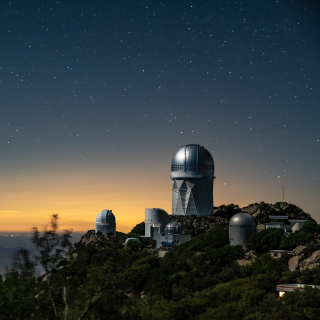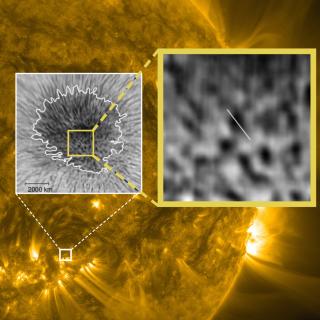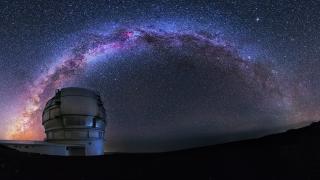The Euclid mission of the European Space Agency (ESA) will be launched into space tomorrow, 1st July to make the largest and most precise 3D map of the Universe. Spain has an important role in this project, where it is part of the the Consortium which has driven the mission since its origin. Spain has also participated significantly in the instrument design of the project, and will contribute to its scientific use. The Instituto de Astrofísica de Canarias (IAC) has collaborated in the design, construction and testing of the control electronics for one of the on-board instruments. It also leads several scientific programmes aimed at using the data from Euclid for cosmological research into the properties of dark matter, the study of the formation and evolution of the galaxies, and the identification of objects of sub-stellar mass.
The Euclid mission of the European Space Agency (ESA) will be launched into space on Saturday 1st July on a Falcon 9 rocket of SpaceX from the Kennedy Space Center, Cape Canaveral, Florida (USA). Several Spanish institutions, among them the IAC, have worked for 11 years on this mission, which will help us to understand dark energy and dark matter. According to current models these dark components form some 95% of the matter and energy content of the Universe, and affect the motions and the distribution of the visible sources, such as the galaxies, even though they neither emit nor absorb light. Because of this science has not been able to determine what they are. Understanding them presents two of the most important challenges in modern cosmology.
“Euclid will observe billions of galaxies up to distances of 10 billion light years, creating a very precise 3D map of a third of the sky”, comments Francisco Castander, a researcher from the ICE-CSIC, the IEEC and member of the board of the Euclid Consortium. “By precisely measuring the position and shapes of galaxies in visible light and inferring their distances, Euclid will help us explore how the universe has expanded and how its structure has formed throughout cosmic history, which may reveal more about the role of gravity and the nature of dark energy and dark matter."
The unprecedented combination of sensitivity, spatial resolution, homogeneity of the data, and spectral information from Euclid will be extremely useful for many areas of astrophysics. “The data from the mission will leave an extraordinary legacy which will let us increase our understanding of the formation and evolution of galaxies, and also about the less luminous astronomical objects in the Milky Way” points out Rafael Rebolo, the director of the IAC and also a member of the board of the Euclid Consortium.
After travelling for a month through space Euclid will arrive at its destination to orbit at the second Lagrange point (L2) of the Sun-Earth system, at 1.5 million kilometres from the Earth in the opposite direction to the Sun. Once there Euclid will capture solar energy to energize itself, and at the same time will point its telescope towards deep space, which will guarantee a high level of stability for its instruments. After that during two monthys it will carry out a series of tests to show that all its components and instruments are working well. Finally, three months after its launch Euclid will start to map the “dark universe” during the six years anticipated for the length of its mission.
Contribution to the instrumentation of Euclid
Euclid has a telescope of diameter 1.2 metres and two instruments: VIS (VISible instrument) and NISP (Near-Infrared Spectrometer and Photometer). The latter is a spectrometer and photometer in the near-infrared which has been developed with strong Spanish participation.
The IAC has collaborated with the Polytechnic University of Cartagena (UPCT) in the design, construction, and testing of the control electronices (Instrument Control Unit, ICU), of the NISP instrument, and in particular of the modules for the monitoring and thermal control, the in-flight calibration unit, and the Grism Wheel Assembly (GWA) and the Filter Wheel Assembly (FWA). The technological contribution of the IAC received the EUCLID Consortium EULER Award for its outstanding contribution to the instrumentation of the mission.
In addition, some 80 European companies participate in Euclid, of which 9 are Spanish, including Airbus, Alter Technology, Crisa, Deimos Space, GTD, Navair, Sener and Thales Alenia Space Spain.
Programmes of scientific use
The IAC is participating in the scientific use of Euclid in three main areas of study. Firstly it has a programme of cosmological research on the properties of dark matter and dark energy, with participation by José Alberto Rubiño, Carlos Hernández, and Ricardo Génova. A second group, which includes Carlos Gutiérrez, Marc Huertas and Helmut Dannerbauer, will use the Euclid data to study the formation and evolution of galaxies.
Finally the SUBSTELLAR project will use observations from the mission to identify an unprecedented number of objects with substellar mass (brown dwarfs and planetary-mass astronomical objects). This programme has funding from the European Research Council via an Advanced Grant, and is led by Eduardo L. Martín Guerrero, a CSIC Research Professor at the IAC and one of the Independent Legacy Scientists of the Euclid Mission, who is coordinating an international team in which seven other members of the IAC are participating.
Euclid has participation by over 300 international institutions, with over 2,000 scientists from 33 European countries, the US, Canada, and Japan, who will benefit for decades from the use of the data from this space mission to continue deepening our understanidng of dark energy and dark matter, the accelerated expansion of the Universe, and the working of gravity, among other subjects. In over 20 Spanish institutions there are over 100 people preparing scientific exploitation of the Euclid mission.
More information
Press release and video by ICE-CSIC, IFAE
Euclid Launch kit [ES],[EN]
ESA’s Live streaming Euclid launch: 1 July, Saturday, from 16:30 CEST
Contact at the IAC:
Rafael Rebolo, rrl [at] iac.es (rrl[at]iac[dot]es)
Carlos Gutiérrez, carlos.gutierrez [at] iac.es (carlos[dot]gutierrez[at]iac[dot]es)
Eduardo Martín, ege [at] iac.es (ege[at]iac[dot]es)

Our goal is to study the processes that lead to the formation of low mass stars, brown dwarfs and planets and to characterize the physical properties of these objects in various evolutionary stages. Low mass stars and brown dwarfs are likely the most numerous type of objects in our Galaxy but due to their low intrinsic luminosity they are not so

The Cosmic Microwave Background (CMB) contains the statistical information about the early seeds of the structure formation in our Universe. Its natural counterpart in the local universe is the distribution of galaxies that arises as a result of gravitational growth of those primordial and small density fluctuations. The characterization of the
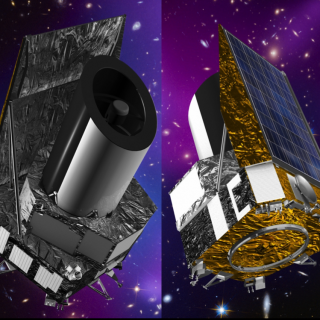
The Near Infrared Spectrometer and Photometer (NISP) is an infrared spectrograph for the EUCLID mission. The aim of EUCLID is to obtain a map of the Dark matter of the Universe. NISP will provide near infrared photometry, low resolution spectra and redshifts of millions galaxies. IAC participates in the development of NISP Instrument Control Unit.

The European Research Council (ERC) has awarded an ERC Advanced Grant, funding for the development of research projects at the frontiers of knowledge, to the Professor of the Higher Council for Scientific Research (CSIC) Eduardo L. Martín Guerrero de Escalante, who is an active researcher at the Instituto de Astrofísica de Canarias (IAC). The project, entitled “Substellar Science with the Euclid Space Mission“ (SUBSTELLAR) has, as one of its main objectives, the use of data from the future space telescope Euclid to increase our knowledge of objects with substellar masses (brown dwarfs and
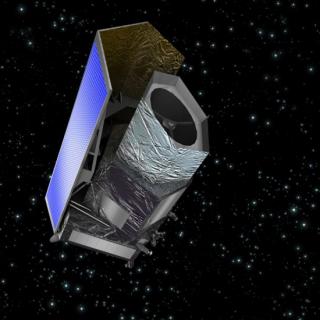
La Agencia Espacial Europea (ESA) acaba de aprobar formalmente la colaboración internacional de unos mil científicos de cien institutos de investigación
